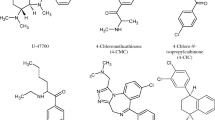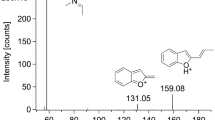Abstract
Purpose
Methyl (S)-2-(1–7 (5-fluoropentyl)-1H-indole-3-carboxamido)-3,3-dimethylbutanoate (5F-MDMA-PICA) intoxication in 1.5-year-old child was presented, together with diagnostic parameters discussion and 5F-MDMB-PICA determination in biological material. Furthermore, 5F-MDMB-PICA metabolites were identified in a urine sample as markers of exposure in situation when a parent compound is not present in specimens.
Methods
Drugs and metabolites were extracted from serum and urine with ethyl acetate both under alkaline (pH 9) and acidic (pH 3) conditions. Hair, after decontamination and pulverization, were incubated with methanol (16 h, 60 °C). The analysis was carried out using ultra-high-performance liquid chromatography–tandem mass spectrometry. For the identification of 5F-MDMB-PICA metabolites, an urine sample was precipitated with cold acetonitrile. Analysis was performed using ultra-high-performance liquid chromatograph with quadrupole time-of-flight mass spectrometer.
Results
5F-MDMB-PICA was determined only in serum sample at concentration of 298 ng/mL. After 1 year, when analysis was repeated, concentration of synthetic cannabinoid in the same sample was only 17.6 ng/mL which revealed high instability of 5F-MDMB-PICA in serum sample. Eight 5F-MDMB-PICA metabolites were identified in urine sample, including two potentially new ones with m/z 391.18964 and m/z 275.14016.
Conclusions
Toxicological analysis confirmed a 1.5-year-old boy intoxication with 5F-MDMB-PICA. Besides the parent drug, metabolites of 5F-MDMB-PICA were identified, including two potentially new ones, together with possible metabolic reactions which they resulted from. Metabolites determination could serve as a marker of 5F-MDMB-PICA exposure when no parent drug is present in biological material.


Similar content being viewed by others
References
le Boisselier R, Alexandre J, Lelong-Boulouard V, Debruyne D (2017) Focus on cannabinoids and synthetic cannabinoids. Clin Pharmacol Ther 101:220–229. https://doi.org/10.1002/cpt.563
Castaneto MS, Gorelick DA, Desrosiers NA, Hartman RL, Pirard S, Huestis MA (2014) Synthetic cannabinoids: epidemiology, pharmacodynamics, and clinical implications. Drug Alcohol Depen 144:12–41. https://doi.org/10.1016/j.drugalcdep.2014.08.005
European Monitoring Centre for Drugs and Drug Addiction (2021) European Drug Report 2021: Trends and Developments, Publications Office of the European Union, Luxembourg. https://www.emcdda.europa.eu/. Accessed 20 Feb 2021
RESPONSE. NPS and related compounds—analytical reports. https://www.policija.si/apps/nfl_response_web/seznam.php. Accessed 6 Nov 2021
Spaderna M, Addy PH, D’Souza DC (2013) Spicing things up: synthetic cannabinoids. Psychopharmacology 228:525–540. https://doi.org/10.1007/s00213-013-3188-4
Mills B, Yepes A, Nugent K (2015) Synthetic cannabinoids. Am J Med 350:59–62. https://doi.org/10.1097/MAJ.0000000000000466
Zuba D, Byrska B, Maciow M (2011) Comparison of “herbal highs” composition. Anal Bioanal Chem 400:119–126. https://doi.org/10.1007/s00216-011-4743-7
Vandrey R, Dunn KE, Fry JA, Girling ER (2012) A survey study to characterize use of Spice products (synthetic cannabinoids). Drug Alcohol Depend 120:238–241. https://doi.org/10.1016/j.drugalcdep.2011.07.011
Hudson S, Ramsey J (2011) The emergence and analysis of synthetic cannabinoids. Drug Test Anal 3:466–478. https://doi.org/10.1002/dta.268
ElSohly MA, Gul W, Wanas AS, Radwan MM (2014) Synthetic cannabinoids: analysis and metabolites. Life Sci 97:78–90. https://doi.org/10.1016/j.lfs.2013.12.212
Banister SD, Longworth M, Kevin R, Sachdev S, Santiago M, Stuart J, Mack JBC, Glass M, McGregor IS, Connor M, Kassiou M (2016) Pharmacology of valinate and tert-leucinate synthetic cannabinoids 5F-AMBICA, 5F-AMB, 5F-ADB, AMB-FUBINACA, MDMB-FUBINACA, MDMB-CHMICA, and their analogues. ACS Chem Neurosci 7:1241–1254. https://doi.org/10.1021/acschemneuro.6b00137
Kleis J, Germerott T, Halter S, Héroux V, Roehrich J, Schwarz CS, Hess C (2020) The synthetic cannabinoid 5F-MDMB-PICA: a case series. Forensic Sci Int 314:110410. https://doi.org/10.1016/j.forsciint.2020.110410
Logan BK, Gurney SMR, Scott KS, Kacinko SL, Presley BC, Logan BK (2014) Pharmacology, toxicology, and adverse effects of synthetic cannabinoid drugs. Forensic Sci Rev 26:53–78
Mogler L, Franz F, Rentsch D, Angerer V, Weinfurtner G, Longworth M, Banister SD, Kassiou M, Moosmann B, Auwärter V (2018) Detection of the recently emerged synthetic cannabinoid 5F-MDMB-PICA in ‘legal high’ products and human urine samples. Drug Test Anal 10:196–205. https://doi.org/10.1002/dta.2201
Truver MT, Watanabe S, Åstrand A, Vikingsson S, Green H, Swortwood MJ, Kronstrand R (2020) 5F-MDMB-PICA metabolite identification and cannabinoid receptor activity. Drug Test Anal 12:127–135. https://doi.org/10.1002/dta.2688
Qin S, Xin G, Wei J, He G, Yuan Z, Liu H, Zhang X, Wang Y, Zhang W, Lu, (2021) Metabolic profiles of 5F-MDMB-PICA in human urine, serum and hair samples using LC–Q exactive HF-MS. J Anal Toxicol. https://doi.org/10.1093/jat/bkab034
Shi Y, Zhou L, Li L, Liu M, Qiang H, Shen M, Shen B, Chen H, Drummer OH, Liu W, Wu H, Xiang P (2020) Detection of a new tert-leucinate synthetic cannabinoid 5F-MDMB-PICA and its metabolites in human hair: application to authentic cases. Front Chem 8:1124. https://doi.org/10.3389/fchem.2020.610312
Risseeuw MDP, Blanckaert P, Coopman V, van Quekelberghe S, van Calenbergh S, Cordonnier J (2017) Identification of a new tert-leucinate class synthetic cannabinoid in powder and “spice-like” herbal incenses: methyl 2-[[1-(5-fluoropentyl)indole-3-carbonyl]amino]-3,3-dimethyl-butanoate (5F-MDMB-PICA). Forensic Sci Int 273:45–52. https://doi.org/10.1016/j.forsciint.2017.01.023
Zawadzki M, Nowak K, Szpot P (2020) Fatal intoxication with N-ethylpentylone: a case report and method for determining N-ethylpentylone in biological material. Forensic Toxicol 38:255–263. https://doi.org/10.1007/s11419-019-00483-0
Zawadzki M, Chłopaś-Konowałek A, Nowak K, Wachełko O, Szpot P (2021) Quantification of 5F-CUMYL-P7AICA in blood and urine from an authentic fatality associated with its consumption by UHPLC–MS/MS. Forensic Toxicol 39:240–247. https://doi.org/10.1007/s11419-020-00555-6
White CM (2017) The pharmacologic and clinical effects of illicit synthetic cannabinoids. J Clin Pharmacol 57:297–304. https://doi.org/10.1002/jcph.827
Castellanos D (2016) Synthetic cannabinoids 2015: an update for pediatricians in clinical practice. World J Clin Pediatr 5:16–24. https://doi.org/10.5409/wjcp.v5.i1.16
Harris CR, Brown A (2013) Synthetic cannabinoid intoxication: a case series and review. J Emerg Med 44:360–366. https://doi.org/10.1016/j.jemermed.2012.07.061
Heath TS, Burroughs Z, Thompson AJ, Tecklenburg FW (2012) Acute intoxication caused by a synthetic cannabinoid in two adolescents. J Pediatr Pharmacol Ther 17:177–181. https://doi.org/10.5863/1551-6776-17.2.177
Forrester MB (2012) Adolescent synthetic cannabinoid exposures reported to texas poison centers. Pediatr Emerg Care 28:985–989. https://doi.org/10.1097/PEC.0b013e31826c9a97
Cohen J, Morrison S, Greenberg J, Saidinejad M (2012) Clinical presentation of intoxication due to synthetic cannabinoids. Pediatrics 129:e1064–e1067. https://doi.org/10.1542/peds.2011-1797
Schneir AB, Baumbacher T (2012) Convulsions associated with the use of a synthetic cannabinoid product. J Med Toxicol 8:62–64. https://doi.org/10.1007/s13181-011-0182-2
Ergül DF, Ekemen S, Büyükkidan Yelken B (2015) Synthetic cannabinoid ‘bonzai’ intoxication: six case series. Turk J Anaesthesiol Reanim 43:347–351. https://doi.org/10.5152/TJAR.2015.05668
Besli GE, Ikiz MA, Yildirim S, Saltik S (2015) Synthetic cannabinoid abuse in adolescents: a case series. J Emerg Med 49:644–650. https://doi.org/10.1016/j.jemermed.2015.06.053
Oluwabusi OO, Lobach L, Akhtar U, Youngman B, Ambrosini PJ (2012) Synthetic cannabinoid-induced psychosis: two adolescent cases. J Child Adol Psychopharmacol 22:393–395. https://doi.org/10.1089/cap.2012.0004
Wargo K, Geveden BN, McConnel VJ (2007) Cannabinoid-induced pancreatitis: a case series. J Pancreas 8:579–583
Cevik B (2013) The catastrophe of the last years: synthetic cannabinoids. Br J Anaesth. https://doi.org/10.1093/bja/el_10956
Templeton K, Omar M, Narahari P (2019) Acute synthetic cannabinoid induced pancreatitis and psychosis. In: Poster presented at: APA alabama state conference, October 2019
Lessard E, Fortin A, Bélanger PM, Beaune P, Hamelin BA, Turgeon J (1997) Role of CYP2D6 in the N-hydroxylation of procainamide. Pharmacogenetics 7:381–390. https://doi.org/10.1097/00008571-199710000-00007
Baba T, Yamada H, Oguri K, Yoshimura H (1988) Participation of cytochrome P-450 isozymes in N-demethylation, N-hydroxylation and aromatic hydroxylation of methamphetamine. Xenobiotica 18:475–484. https://doi.org/10.3109/00498258809041684
Pellinen P, Kulmala L, Konttila J, Auriola S, Pasanen M, Juvonen R (2000) Kinetic characteristics of norcocaine N-hydroxylation in mouse and human liver microsomes: involvement of CYP enzymes. Arch Toxicol 74:511–520. https://doi.org/10.1007/s002040000154
Kong TY, Kim JH, Kim DK, Lee HS (2018) Synthetic cannabinoids are substrates and inhibitors of multiple drug-metabolizing enzymes. Arch Pharm Res 41:691–710. https://doi.org/10.1007/s12272-018-1055-x
Allegaert K, van den Anker JN, Naulaers G, de Hoon J (2007) Determinants of drug metabolism in early neonatal life. Curr Clin Pharmacol 2:23–29. https://doi.org/10.2174/157488407779422294
Nowak K, Szpot P, Zawadzki M (2020) The stability of 4-chloromethcathinone in blood and vitreous humor. J Forensic Sci 65:1784–1790. https://doi.org/10.1111/1556-4029.14454
Nowak K, Szpot P, Zawadzki M (2019) Unstability of 4-CMC in human serum specimen. Forensic Toxicol 37:261–264. https://doi.org/10.1007/s11419-018-0455-4
Krotulski AJ, Bishop-Freeman SC, Mohr AL, Logan BK (2021) Evaluation of synthetic cannabinoid metabolites in human blood in the absence of parent compounds: a stability assessment. J Anal Toxicol 45:60–68. https://doi.org/10.1093/jat/bkaa054
Acknowledgements
The authors thank the SHIM-POL A. M. Borzymowski Company for the opportunity to carry out the analysis of the 5F-MDMB-PICA metabolites with the use of the UHPLC–QTOF–MS–MS 9030 system.
Funding
No funding was received to assist with the preparation of this manuscript.
Author information
Authors and Affiliations
Corresponding author
Ethics declarations
Conflict of interest
The authors declare no conflicts of interest (including financial and personal) that might appear to influence the work reported in this paper.
Ethical approval
This article does not contain any studies with human participants or animals performed by any of the author.
Additional information
Publisher's Note
Springer Nature remains neutral with regard to jurisdictional claims in published maps and institutional affiliations.
Supplementary Information
Below is the link to the electronic supplementary material.
Rights and permissions
About this article
Cite this article
Szpot, P., Nowak, K., Wachełko, O. et al. Methyl (S)-2-(1–7 (5-fluoropentyl)-1H-indole-3-carboxamido)-3,3-dimethylbutanoate (5F-MDMB-PICA) intoxication in a child with identification of two new metabolites (ultra-high-performance liquid chromatography–tandem mass spectrometry). Forensic Toxicol 41, 47–58 (2023). https://doi.org/10.1007/s11419-022-00629-7
Received:
Accepted:
Published:
Issue Date:
DOI: https://doi.org/10.1007/s11419-022-00629-7




